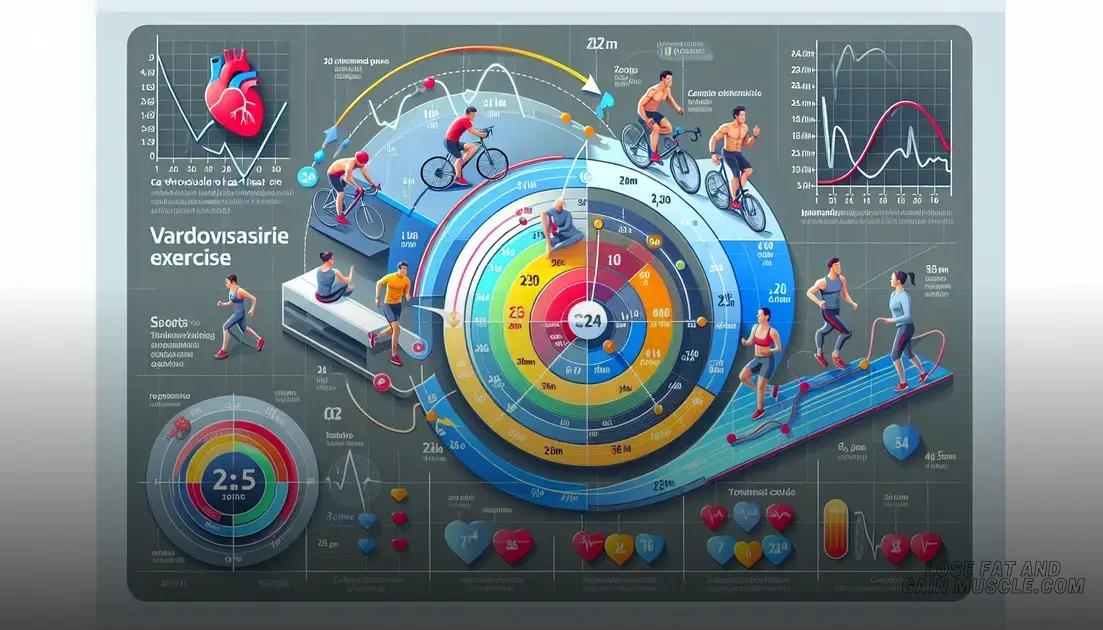Does Cardio Burn Belly Fat? Discover the Truth Behind Fat Loss
Cardio can aid in burning belly fat by increasing calorie expenditure, but it should be combined with strength training and proper nutrition for optimal results. Spot reduction is a myth, and a balanced approach is essential for effectively reducing overall body fat, including belly fat.
Curious about whether cardio truly burns belly fat? You’re not alone! Many fitness enthusiasts and beginners alike seek to understand the effectiveness of cardio in targeting stubborn belly fat. This article delves into the science behind cardio exercises, how they stack up against other forms of training, and the integral role nutrition plays in fat loss. Let’s get to the bottom of this popular gym topic.
Understanding Belly Fat
Belly fat, also known as visceral fat, is the fat that accumulates around the abdominal organs. Understanding this type of fat is crucial for anyone looking to improve their health and fitness. It is essential to note that belly fat is not just a cosmetic issue; it is linked to various health risks.
What Causes Belly Fat?
There are several factors that contribute to the accumulation of belly fat. Poor diet, lack of physical activity, genetics, and hormonal changes can all play a significant role. High consumption of sugary foods and beverages, along with sedentary lifestyles, often lead to increased fat storage in the abdominal area.
Health Implications of Belly Fat
Excess belly fat can lead to serious health problems, including type 2 diabetes, heart disease, and certain cancers. It is more dangerous than fat found in other areas of the body because it wraps around vital organs, affecting their function.
Measuring Belly Fat
To assess belly fat, people can use methods such as waist circumference measurements or the waist-to-hip ratio. A waist measurement of more than 40 inches for men and more than 35 inches for women is generally considered a warning sign.
Importance of Reducing Belly Fat
Reducing belly fat is not only about aesthetics; it can significantly improve overall health. Losing belly fat can increase insulin sensitivity and reduce inflammation, leading to a healthier body and decreased risk of chronic diseases.
How Cardio Fits In
Now that we understand belly fat, we can see where cardio comes into play. Cardio exercises can help burn calories and reduce body fat, including that stubborn belly fat. Combining cardio with a healthy diet is the most effective way to achieve desired results.
In summary, understanding belly fat is crucial for implementing effective strategies to combat it. Knowing what causes it, how it impacts health, and the ways to measure it can empower individuals to take control of their fitness journeys.
The Science of Cardio

The science behind cardio exercise is key to understanding its effectiveness in burning fat, particularly belly fat. Cardio, short for cardiovascular exercise, gets your heart rate up and increases blood circulation! This type of exercise can include activities like running, swimming, cycling, and even brisk walking.
How Cardio Works
When you engage in cardio, your body primarily relies on glycogen stored in your muscles and liver for energy. As you continue exercising, your body starts to burn fat for fuel. This is important because fat loss occurs primarily when you burn more calories than you consume.
Effects on Belly Fat
Studies show that regular cardio can help reduce overall body fat, including abdominal fat. Consistent aerobic activity can help create a calorie deficit, leading to weight loss. It’s also noted that people who perform high-intensity interval training (HIIT) experience greater fat loss compared to moderate cardio.
Duration and Intensity
The duration and intensity of cardio play a significant role in fat loss. Moderate-intensity workouts should last at least 150 minutes per week, while vigorous activities can be around 75 minutes. Finding a balance that maintains a higher heart rate will more effectively target fat burning.
Heart Rate Zones
Understanding heart rate zones is also crucial. Keeping your heart rate within the fat-burning zone (60-70% of your max heart rate) can help optimize fat loss during cardio. It’s beneficial to incorporate different intensities into your routine to keep your body engaged.
The Role of Rest and Recovery
Lastly, rest is equally important in the science of cardio. Allowing your body time to recover helps boost performance and increases the potential for fat loss. Overtraining can lead to fatigue and decreased workout effectiveness, so balance is essential.
Different Types of Cardio Exercises
Cardio exercises come in many forms, each with unique benefits. Incorporating a variety of cardio workouts into your routine can keep things exciting and target different fitness aspects!
1. Steady-State Cardio
Steady-state cardio involves performing an exercise at a consistent and moderate intensity for an extended period. Activities like jogging, cycling, and swimming fit this category. These exercises are great for building endurance and can help in burning fat.
2. High-Intensity Interval Training (HIIT)
HIIT consists of short bursts of intense exercise followed by rest or low-intensity periods. For example, sprinting for 30 seconds followed by a slow walk for 1 minute. HIIT is efficient for maximizing calorie burn in a shorter amount of time and can be very effective for fat loss.
3. Circuit Training
Circuit training combines strength training with cardio exercises. You move through a series of exercises with little rest in between. This method can elevate your heart rate, make workouts more engaging, and build both strength and cardiovascular fitness.
4. Low-Impact Cardio
Low-impact cardio exercises include activities like walking, swimming, and using an elliptical machine. These workouts are easier on the joints and suitable for all fitness levels. They can also be performed for longer durations, promoting fat loss without the risk of injury.
5. Dance and Aerobics
Dance-based workouts, such as Zumba or aerobics classes, are fun ways to get your heart rate up. They offer an enjoyable way to burn calories while improving coordination. These workouts can help with weight loss, especially when done regularly.
6. Sports and Recreational Activities
Participating in sports, like basketball, soccer, or tennis, is a great way to engage in cardio without it feeling like a chore. These activities improve fitness while providing social interaction, making them an excellent addition to your cardio routine.
Cardio vs. Strength Training

When discussing fitness, it’s important to compare cardio and strength training as they both have unique benefits for fat loss and overall health.
Cardio Training
Cardio, such as running or cycling, focuses on improving heart health and burning calories. It is effective for enhancing endurance and boosting metabolism during and after workouts. Cardio exercises are excellent for burning fat, especially when combined with a proper diet.
Strength Training
In contrast, strength training, which includes weight lifting and bodyweight exercises, builds muscle mass. Increasing your muscle mass can raise your resting metabolic rate, which means you’ll burn more calories even when not exercising. This can lead to long-term fat loss and a toned appearance.
Caloric Burn
While cardio may burn more calories during exercise, strength training can lead to higher overall calorie burn throughout the day. This is due to the muscle-building process, which requires energy, making strength training a beneficial addition to any weight loss plan.
Combining Both for Best Results
The best approach to fitness is to combine both cardio and strength training. This allows you to enjoy the benefits of cardiovascular health while also increasing muscle strength. A balanced workout routine can improve body composition, enhance fat loss, and keep the workouts diverse and interesting.
Flexibility and Functionality
Incorporating both types of training can also improve flexibility and functional fitness. Moreover, different forms of strength training enhance your overall performance in cardio activities, helping to prevent injuries while exercising.
Understanding the differences between cardio and strength training can help you create a personalized fitness plan that maximizes your fat loss efforts and supports your overall health.
Nutrition’s Role in Belly Fat
Nutrition plays a crucial role in determining how much belly fat you have. What you eat can significantly impact fat storage and body composition!
Foods to Limit
Foods high in refined sugars, unhealthy fats, and processed ingredients can lead to increased belly fat. Examples include sugary drinks, candies, and fried foods. Limiting these can help control overall calorie intake and reduce fat accumulation.
Importance of Lean Protein
Eating lean protein can help build muscle and promote feelings of fullness. Foods like chicken, fish, beans, and lentils should be included in a healthy diet. Higher protein intake can reduce hunger levels and assist in burning more calories.
The Role of Fiber
Fiber-rich foods, such as fruits, vegetables, whole grains, and nuts, are beneficial because they keep you full longer and help regulate your digestive system. Eating more fiber can assist in reducing overall body fat, including belly fat.
Healthy Fats
Including healthy fats in your diet is essential for fat loss. Sources like avocados, olive oil, and nuts can provide necessary nutrients while helping you feel satisfied. Replacing saturated fats with healthy fats can promote better heart health and improve metabolic functions.
Hydration Matters
Staying well-hydrated is often overlooked in discussions about nutrition and fat loss. Drinking plenty of water can help control hunger and boost metabolism. Aim for at least eight glasses of water a day, and consider herbal teas or infused water for variety.
Meal Timing
Meal timing can also impact fat loss. Eating smaller, more frequent meals throughout the day can help control hunger and maintain energy levels. Alternatively, some people find success with intermittent fasting, which can also promote fat loss.
By focusing on nutrition and making smart food choices, you can effectively manage and reduce belly fat while enhancing your overall health.
Myths About Belly Fat and Cardio

There are many myths surrounding belly fat and cardio that can confuse those trying to lose weight. Debunking these myths can help you understand the truth about fat loss and make better choices.
Myth 1: Spot Reduction is Possible
Many people believe that doing a lot of cardio can target belly fat specifically. However, spot reduction is a myth. When you lose weight, you cannot choose where the fat comes off. Cardio can help reduce overall body fat, including belly fat, but it occurs throughout the body, not just in one area.
Myth 2: More Cardio Always Means More Fat Loss
While cardio is important for burning calories, more is not always better. Excessive cardio without proper strength training or recovery can lead to muscle loss and might result in weight plateaus. Balance is crucial for effective fat loss.
Myth 3: Cardio is Enough on Its Own
Some believe that doing cardio is the only thing needed to lose belly fat. In reality, combining cardio with strength training and proper nutrition is essential. Strength training helps build muscle, which can, in turn, boost your metabolism.
Myth 4: You Must Do Cardio for Long Durations
Another common myth is that you need to do long hours of cardio to see results. Short, high-intensity workouts, like HIIT, can be just as effective, if not more so. They save time and can lead to greater fat loss in shorter periods.
Myth 5: Only Cardio Burns Fat
Many think that only cardio exercises can torch calories. However, strength training also burns calories and has a lasting effect on your metabolism. The more muscle you have, the more calories you burn at rest.
Myth 6: Cardio Should Be Done Daily
While consistency is vital, you don’t need to do cardio every day. Your routine should incorporate various types of exercises, including rest days to allow your body to recover and grow stronger.
By separating fact from fiction, you can create a more effective plan for reducing belly fat through a balanced approach of cardio, strength training, and proper nutrition.
In Conclusion: The Path to Reducing Belly Fat
Achieving fat loss, particularly in the belly area, requires a comprehensive approach. Understanding the science behind cardio and its various forms is essential.
While cardio exercises play a critical role in burning calories, incorporating strength training and focusing on nutrition can significantly enhance your results. It’s crucial to debunk common myths that might mislead your fitness journey, ensuring that you have accurate information to guide your decisions.
By combining effective cardio routines, a smart strength training regimen, and a balanced diet, you can take significant steps toward reducing belly fat and improving your overall health.
Remember, consistency and balance in your fitness approach will yield the best long-term results.
FAQ – Frequently Asked Questions about Cardio and Belly Fat
Does cardio specifically target belly fat?
No, cardio cannot target belly fat specifically. When you lose weight, it occurs throughout your body, not in one specific area.
Is more cardio always better for losing belly fat?
Not necessarily. Excessive cardio without strength training can lead to muscle loss and may hinder fat burning. Balance is key.
Can I rely only on cardio for fat loss?
No, combining cardio with strength training and proper nutrition is essential for effective fat loss and overall health.
What types of cardio are most effective for fat loss?
High-Intensity Interval Training (HIIT), steady-state cardio, and circuit training can be very effective for burning fat.
How important is nutrition in reducing belly fat?
Nutrition is crucial. Eating a balanced diet with lean proteins, healthy fats, and plenty of fiber can help control belly fat.
Can strength training help with fat loss?
Absolutely! Strength training builds muscle, which can increase your resting metabolic rate and aid in fat loss.













